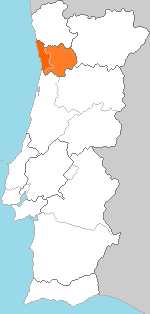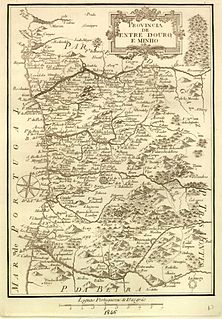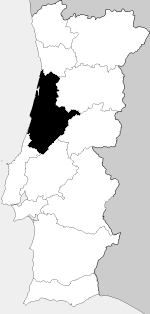
Administratively, Portugal is de jure unitary and decentralized state. Nonetheless, operationally, it is a highly centralized system with administrative divisions organized into three tiers. The State is organized under the principles of subsidiarity, local government autonomy, and democratic decentralization of the public service.

Sofala is a province of Mozambique. It has a population of 2,259,248. Beira is the capital of the province, named for the ruined port of Sofala which is 35 kilometres (22 mi) to the south.

The District of Leiria is a district located in Centro region of Portugal, divided between the traditional provinces of Beira Litoral and Estremadura. It borders on the north with district of Coimbra, on the east with district of Castelo Branco and with district of Santarém, on the south with district of Lisbon and on the west with the ocean Atlantic. The district capital is the city of Leiria.
A comarca is a traditional region or local administrative division found in Portugal, Spain and some of their former colonies, like Panama, Nicaragua, and Brazil. The term is derived from the term marca, meaning a "march, mark", plus the prefix co-, meaning "together, jointly".
Bairrada is a Portuguese wine region located in the Beira Litoral Province. The region has Portugal's highest wine classification as a Denominação de Origem Controlada (DOC), and its popularity has surged over the last years. It is small and quite narrow coastal region, part of the broader region of Beira Atlântico, and it is bordered to the northeast by the Lafões IPR and to the east by the Dão DOC.

Beira was one of the six traditional provinces or comarcas of Portugal.

The Turduli or Turtuli were an ancient pre-Roman people of the southwestern Iberian Peninsula.

Douro Litoral is a historical province of Portugal. It is centered on the city of Porto, now the capital of the Norte Region. Other important cities in the province are Vila Nova de Gaia, Matosinhos, Maia, Póvoa de Varzim, and the historically important Penafiel, Amarante, Feira, Vila do Conde.

Entre Douro e Minho is one of the historical provinces of Portugal which encompassed the country's northern Atlantic seaboard between the Douro and Minho rivers. Contemporaries often referred to the province as simply "Minho". It was one of six provinces Portugal was commonly divided into from the early modern period until 1936, although these provinces were not recognized as official units of government.

Póvoa de Varzim, with an area of 82.06 square kilometres, lies between the Cávado and Ave Rivers, or, from a wider perspective, halfway between the Minho and Douro Rivers on the northern coast of Portugal. Although in administrative reforms of 1936, the city was integrated in Douro Litoral, the case for such an administrative integration is arguable, because Póvoa de Varzim is found in a transition region. It has characteristic Minho traditions, historical and demographic bounds with several towns and villages in the region, religiously it is part of Braga archdiocese, and due to that it is perhaps preferable to recognize Póvoa as part of the old region, favouring more Entre-Douro-e-Minho, given its central geographic position in this region.

The subdivisions of Portugal are based on a complicated administrative structure. The second-level administrative division, after the 5 regions and 2 autonomous regions, is 308 municipalities (concelhos) which are further subdivided into 3091 civil parishes (freguesias).

Beira Litoral is a former province (província) of Portugal, formally instituted in an administrative reform of 1936. The territory corresponds mainly to the Douro Province from the 19th century. It was abolished with the 1976 Constitution of Portugal.
The Portuguese postal code is formed by four digits, a hyphen, then three digits, followed by a postal location of up to 25 characters in capitals.
Avenida Marconi 4C 1000-260 Lisboa

The term "provinces" has been used throughout history to identify regions of continental Portugal. Current legal subdivisions of Portugal do not coincide with the provinces, but several provinces, in their 19th- and 20th-century versions, still correspond to culturally relevant, strongly self-identifying categories. They include:

Beira Litoral may refer to:

Estremadura Province is one of the six historical provinces of Portugal. It is located along the Atlantic Ocean coast in the center of the country and includes Lisbon, the capital. The name of this province originates from the Spanish and Portuguese struggle with the Moors, and the Christian reclaiming of their land in the 12th century. These provinces were called Extrema Durii, which means "farthest from the Douro River."

The rabeca or rabeca chuleira is a fiddle originating in Portugal, commonly used in both Portugal and Northeastern Brazil, where it is most commonly used in Brazilian forró music. It is descended from the medieval rebec.

The intermunicipal community is a type of administrative division in Portugal. Since the 2013 local government reform, there are 21 intermunicipal communities. They replaced the urban communities, the intermunicipal communities for general purposes and some metropolitan areas that were created in 2003, and abolished in 2008. The territories of the intermunicipal communities are the basis of the NUTS III statistical regions.
Maurício José Ferreira da Costa de Abreu is a Portuguese photographer, editor and cultural producer. He is a leading name in Portuguese photography, as a specialist in the areas of natural and cultural patrimony, ethnography and traditional architecture.













